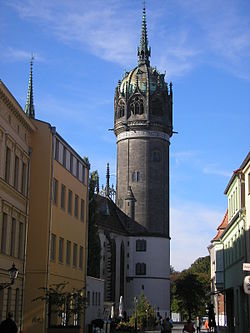| |||
 | |||
| Country | Germany | ||
| Region | Saxony-Anhalt | ||
| Population | 46 000 (2018) | ||
| High | 75m | ||
Vitenbergo (German: Wittenberg, official Lutherstadt Wittenberg) is a city in Saxony-Anhalt in the east Germany.
Understand
Wittenberg is located in the former East Germany, about halfway between Berlin and Leipzig, in Saxony-Anhalt. The core of the city lies on a low hill overlooking the river Elbe, which enters a vast plain shortly to the east.
History
In the 16th century, Wittenberg was an important university town. Here, in 1517, Luther nailed his famous Ninety-five Theses on the gate of the palace church.
The history of Vitenberg before that event is not long. A village founded between the 10th and 12th centuries, it was elevated to a "city" only in 1293. Trade was good, thanks to the river Elbe, which could be crossed here by a bridge.
Very favorable to the city were the decisions of Ernest of Saxony and his son Frederick III of Saxony. Ernest chose Vitenberg as the capital of his principality in 1485, and Frederick founded the university in the city in 1502. A few years later Luther came to Vitenberg precisely because of that university.
In 1547 the prince of Wittenberg was imprisoned and the country became under the rest of Saxony, whose capital was Dresden. Wittenberg lost its role as capital.
Very important for the city the long wars during centuries XVII and XVIII were. The most painful events, among many others, took place in 1637, when the Swedish general Johan Banér attacked Vitenberg, already suffering from hunger and influx of refugees, and, though unable to capture it, destroyed the main bridge across the river; and in 1760, when the city was occupied by Prussians and bombed by Austrians, with the destruction of great part of the center.
In 1806 the city and all of Saxony passed under Napoleon, and in 1814 under Prussia. Later both followed Berlin in all the occasions: the emergence of the new Empire of Germany in 1871; after World War II, the division of Germany, when Vitenberg also came under Russian control (East Germany); in 1989 the reunification of Germany.
During World War II there were no major bombings in Vitenberg.
The university founded in 1502 still exists, however in 1807 it merged with the University of Halle, so it is called "University of Halle-Wittenberg".
Climate
Vitenberg's climate is moderate and continental.
Winters are cold, with average temperatures mostly around zero (a little more during the day, a little less at night). Summers have moderately hot days, mostly with temperatures around 20/25 ° C, and cool nights, mostly with temperatures around 10/15 ° C.
Rainy days (or snow days) are about 15 in each month.
Access
Aliri avie
The nearest airports are:
- en Berlin (two airports) - website for both: https://www.berlin-airport.de/, available in German, English and Polish
- en Leipzig - website: https://www.leipzig-halle-airport.de/, available in German and English
- en Hanover (further) - website: https://www.hannover-airport.de/, available in German and English
Berlin is connected to many cities both in Europe and outside Europe.
In Leipzig there are regular flights to / from the major cities in southern and western Germany and to / from other destinations in Europe and North Africa, mostly tourist destinations for Germans.
Hanover has more connections than Leipzig, in Europe and around the Mediterranean, but its airport is more remote and poorly connected.
From Berlin and Leipzig it is possible to reach Wittenberg by train with one change (at the main station of Berlin or Leipzig); only from Berlin Tegel is also needed a bus from the airport to the nearby station. You can also travel by bus, car or taxi.
Access by train
Vitenberg railway station is a railway junction of the Leipzig-Berlin line with lighter lines. The best connections are only to Berlin (approx. 40min, usually every hour) and to Leipzig (approx. 30min, usually every hour). There are several trains to Halle-Erfurt; Erfurt is a suitable place for changes to Frankfurt, Munich etc.
Access bus
Access by car
Wittenberg is close to the A-9 Munich-Leipzig-Berlin motorway. Exit at Coswig, then c. 20km along B-187.
Access by ship
There are ships cruising along the river Elbe (for example from Hamburg). They usually stop in Wittenberg and allow a short tour of the city.
To be transported
To be transported on foot
Public transport
Transport by car
See


1 - Castle Church or Palace Church (Schlosskirche).

2 - Municipal Church dedicated to Santa Maria (Stadtkirche).

3 - Catholic church Immaculate Conception (Unbefleckte Empfängnis).
4 - Prince's Castle or Prince's Palace (Residenzschloss).

5 - Old City council (Altes Rathaus), built in the 16th century.

6 - Old it soothes of the famous one Leucorea University, founded in 1502.

7 - House of Luther (Lutherhaus), where Martin Luther lived from 1524 until his death, and August (Augusteum), originally an additional building of Leucorea University.

20 - Butterfly Park Alaris (Schmetterlingspark Alaris), where many species of butterflies can be seen. It is located approx. 3.5km west of the city (connected by bus line 301).
Fari
Buy
Stores
Eat
Drink
To live
Campsites
It is worth mentioning Marina Camp next to the south bank of the river Elbe, in front of the city (which is next to the north bank).
Hostels
Hotels
Security
Esperanto
Due to the history of Vitenberg and the presence there in the 16th century of Martin Luther, Vitenberg was chosen for the Bible Days (religious Esperanto meeting) in 2017.
In 2020 (around Easter) the 36th PSI (International Spring Week) took place in Vitenberg.
At the end of the year 2020 will take place in Vitenberg Youth E-Week.

